 |
||
|
||
| ||
The last modification of the Intel Pentium III was Coppermine released two years ago - in October 1999. Since then Pentium III processors haven't undergone any major changes: the developers altered only the core stepping (the third, and the last for today, is D-step, or cD0). All other features - fab process, architecture, size and L2 cache frequency remain untouched. At the same time AMD launched a new core Athlon Thunderbird, lifted the frequency of the AMD Duron based on the Thunderbird, and gradually reduced its price. As a result, Intel's processors started losing to the AMD's products in price/performance ratio. The obsolescent core and a 0.18 micron process didn't allow the Pentium III Coppermine work faster than 1 GHz. Besides, the exclusive L2 cache of the AMD Athlon performed much better in some tasks than the two-year old Advanced Transfer Cache of Intel processors. The Intel Pentium Xeon was leading for a long time in the sector of multiprocessor systems based on the X86 architecture because of an absence of a dual-processor chipset supporting the AMD Athlon. But when the Athlon MP and AMD 762 were released the Intel's domination shook even there. Such situation didn't satisfy Intel. Its flagship - Intel Pentium 4 - wasn't very popular because of a too high price of finished products on it, which, at the same time, didn't show the expected performance. And the only way-out was a release of a successor of the Pentium III Coppermine - Pentium III Tualatin. First of all, this solution has a twice larger L2 cache: 512 against 256 KBytes. The Tualatin is based on the 0.13 micron copper fab process. First of all, this allowed placing a twice larger L2 cache, and secondly, power consumption and heat dissipation became less because of the reduced power supply (1.5 V for the server version and 1.2 V for the mobile one). 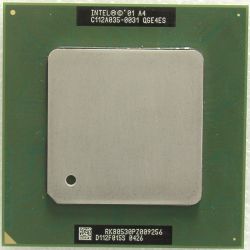 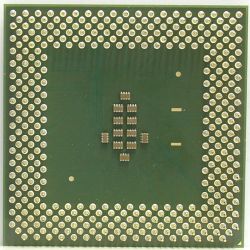 The processor core is covered with an IHS (Integrated Heat Spreader) - a metallic plate protecting the die from damaging and improving heat exchange. The Tualatin will have two versions - for servers and workstations (Pentium III-S) and for notebooks (Pentium III-M). The difference lies in the power supply and in the support of the SpeedStep technology by the mobile version (it is meant for reducing power consumption from batteries). Besides, initially there was also a version for desktop computers - Pentium III-A with 256 KB L2 cache. Exactly this processor is under investigation today. The Pentium III-A is positioned in the value system segment and will work at 100MHz of FSB. No modifications for 133 MHz are planned to be released. The desktop version of the Tualatin will replace the Celeron family while Performance and Mainstream segments are meant to save Intel Pentium 4. Old motherboards do not support Tualatin, and the latter will work only on a mainboard based on the i815 B-step with FC-PGA2 connector. Well, looking at this processor, we may say that it promises good prospects. First of all, with the 0.13 micron process and the reduced power consumption the processor must show a good overclocking potential. Secondly, the increased L2 cache (in the server version) will help to compete against the AMD Athlon which easily won from the Intel Pentium III Coppermine because of the 256 KB L2 cache. BoardFirst of all, let me introduce the ASUS TUSL2-C, a motherboard released specially for the Tualatin. 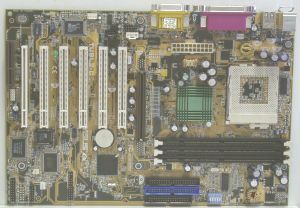
You can see, that the TUSL2-C is almost identical to its predecessors - CUSL2-C and CUSL2-CB. Package and complete setA standard red package contains a printed out description of the board with short installation instructions, cables for IDE devices and for an FDD. Despite a scarce description we faced no problem when installing the board. Such a small set of accessories can be explained by the pre-production version; and we hope that in future we can find a normal user's guide and all pleasant trifles we are used to. 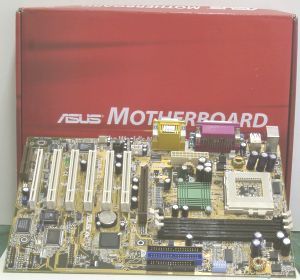 Besides, in the box you can find a CD with drivers and software, among which are Adobe Acrobat Reader, Trend PC-Cillin 2000 and several CyberLink programs - PowerPlayer SE 5.0, Power DVD 2.55, VideoLive Mail 3.10. Besides, there are utilities for system monitoring, a proprietary screensaver and AsusUpdate. On the whole, the board doesn't differ from its predecessors - in this case a new layout is not required. And if you have never read about ASUS boards on i815XX chipset before, I'll tell you about their peculiarities in short. The TUSL2-C lacks for attached elements, the soldering is high-quality and neat. The layout is the most popular for today - an AGP slot, 6 PCIs and 1 CNR. A power supply connector, CD-in and Aux-in are located not very good. The former is located between a socket and an AGP slot what makes power switching on/off difficult, especially with an AGP video card installed. The latter two are located in front of PCI slots. If expansion cards are inserted into the first PCI slots the connectors are difficult to reach. The board has a normal audio chip from C-Media - CMI8738 which allows lowering the CPU load as compared with AC'97 codecs and provides for sound output onto a 6-speaker system. ASUS, being unsatisfied with the hardware monitoring of the chipset, provides its own chip - ASIC AS99127F. The board contains connectors for a Smart Card Reader, an ASUS iPanel, an external unit of audio connectors and an IRDA-port. To improve the stability the developers equipped the board with 8 1500uF and 2 3300 uF capacitors. The chipset's and memory's power is set to 3.45V at default. But it can be changed from 3.3 V to 3.6 V from the BIOS. The FSB frequency can be changed either with jumpers or from the BIOS Setup. The BIOS is based on the 6.00 Medallion from Award. Here you can change the FSB frequency in 1 MHz steps, adjust memory timings etc. The only difference with the previous versions is lack of a possibility to change Vcore. That is why we managed to overclock this sample only up to 1.260 MHz (140x9). In general, the board is reliable, with a lot of possibilities in adjusting different features. Test system configuration and testing techniqueThe Intel Pentium III (D-step) 1.13 GHz was chosen a competitor. The Intel Pentium III Tualatin was tested in two modes: in the rated (1.13 GHz) and in the overclocked (1.26 GHz). To estimate the performance of the TUSL2-C board with the old Intel Pentium III we have taken the ASUS CUSL2-CB, since exactly this one will be replaced with the TUSL2-C. The other equipment is:
Software:
The tests in the SPEC Viewperf and 3D Studio Max were conducted in 1280x1024x32. In 3D Studio Max 10 frames of the Waterfall scene were rendered at 640X480. The tests in the Quake III Arena were conducted at 16-bit color; 32-bit textures were used only in 1024X768X32 and 1280X1024X32. The following modes were set: Fast (for 640X480), Normal (800X600), High (1024X768 and higher). At 1280X1024 all parameters were set to the maximum. 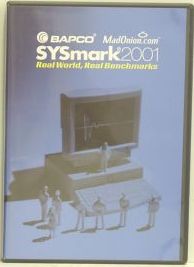 One of the programs for estimation of the system performance was a new packet form Bapco and MadOnion - SYSmark 2001. It implements scripts in different software products and measures time of test implementation. The result is given not for each product used in the tests, like in the previous version SYSmark 2000, but is calculated when all tests are completed. Besides, in the new version applications are started not successively but simultaneously, like in real conditions, and during the test they are switching from one to another. The new packet from Bapco uses new software products. The software set has changed. But the tests based on Microsoft Word, Excel and Power Point 2000 remained untouched. The part which demonstrates the performance in typical business applications has acquired WinZip 8.0 and tests based on the McAfee VirusScan. As for Internet content creation packets, they have also undergone changes: Elastic Reality 3.1 and MetaCreations Bryce 4 were replaced with more popular Macromedia Flash 5 and Macromedia DreamWeaver 4. The following table contains all applications used in the SYSmark 2001 and SYSmark 2000 packets:
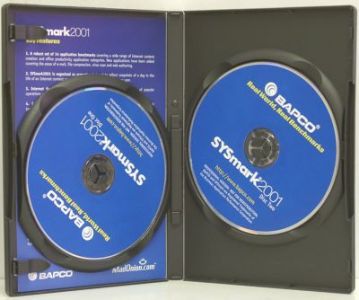  After we have tested the processor at 1.13 and at 1.26 MHz the difference in the SYSmark 2000 calculated as an average of the sum of all results was about 8% while in the SYSmark 2001 it was almost 5%. Well, the new test from Bapco is a worthy successor, being as accurate as its predecessor. This one also reflects a real situation with the help of modern applications. Performance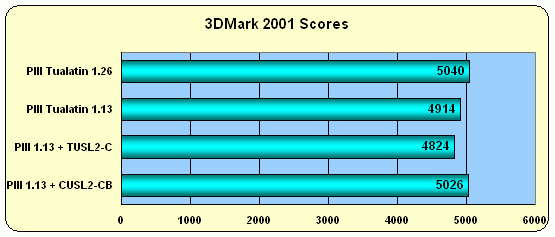 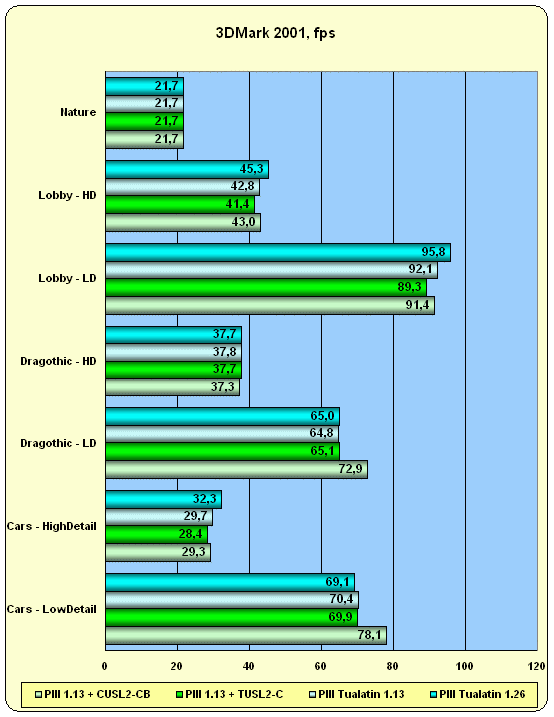 In general, the Tualatin working at 140 MHz FSB is a leader, but the Intel Pentium III 1.13 GHz working on the CUSL2-CB board has fallen behind so insignificantly, that it can be taken as inaccuracy of measurements. So, we can see that the processor working at a lower clock speed shows the greater performance, doesn't it? No, the matter is not in the processor. You should look at the results of the Intel Pentium III 1.13 GHz on CUSL2CB and TUSL2-C. And the explanation is that our TUSL2-C is just a pre-production sample. I hope that the developers will eliminate all drawbacks and improve the BIOS. 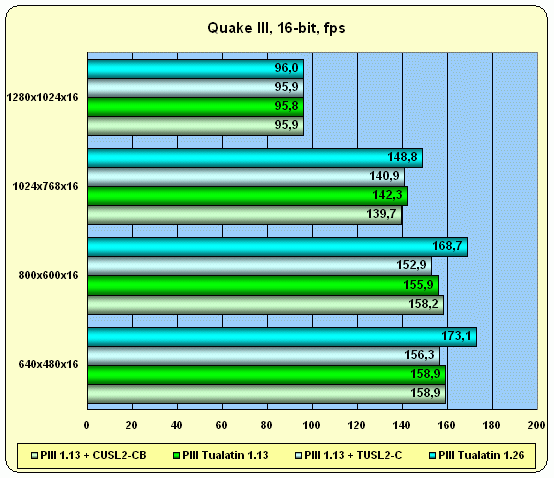  The results shown by the testing sample in the Quake 3 are almost identical in 16-bit and in 32-bit color. The overclocked Tualatin wins from the PentiumIII by a great margin, but when at the same frequency, it shows just a bit better score. The difference between them doesn't depend either on a resolution or color since the platform is the same. 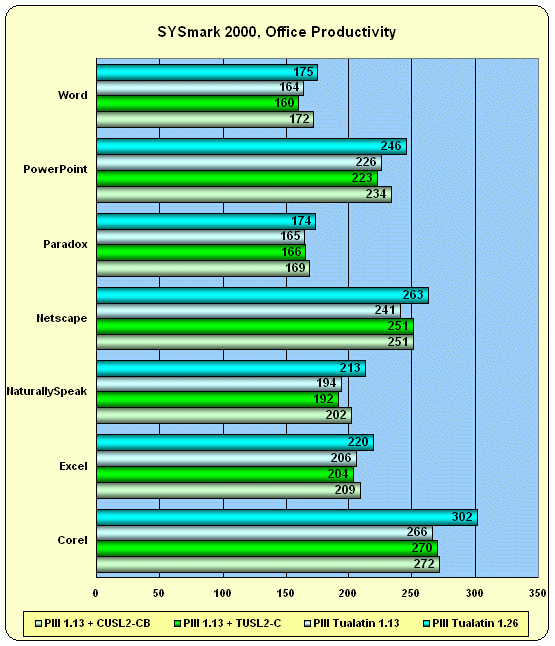 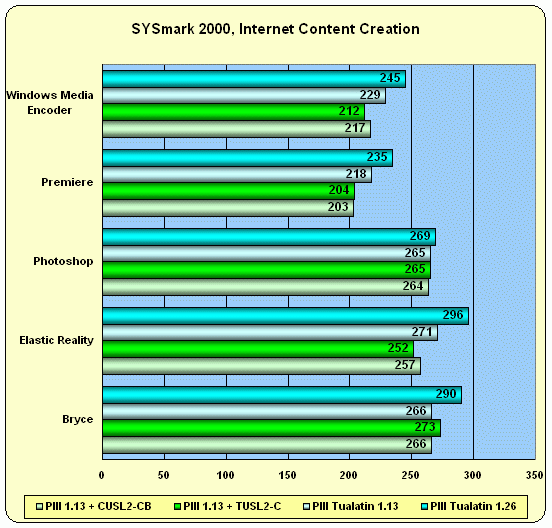 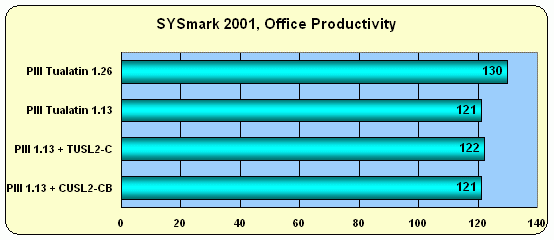 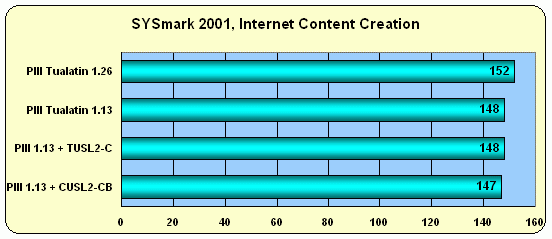 Since the results in the SYSmark 2000 and SYSmark 2001 are similar and supplement each other, we will consider them together. While in the SYSmark 2000 Office Productivity the Tualatin performs just a bit better than the PIII 1.13 GHz (in Corel Draw 9.0 the latter even outscores our hero), in the SYSmark 2000 Internet Content Creation the difference is more vivid since this application requires higher processing power. Their performance is identical only in Adobe Photoshop and Elastic Reality. Besides, the TUSL2-C again lags behind its predecessor - CUSL2-CB. In the SYSmark 2001 the total score is equal for both processors. 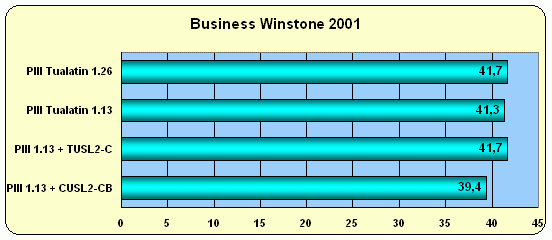 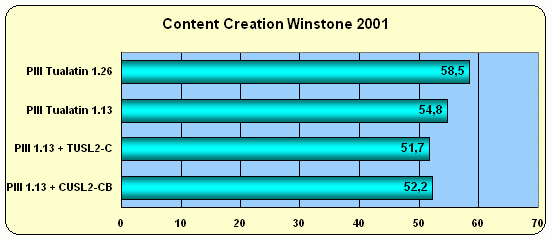 In the Ziff-Davis Media Business Winstone 2001 and Ziff-Davis Media Content Creation Winstone 2001 the results are absolutely equal to the given above - the processors have almost the same productivity in the Media Business, while in the Media Content Creation the Tualatin takes the lead. 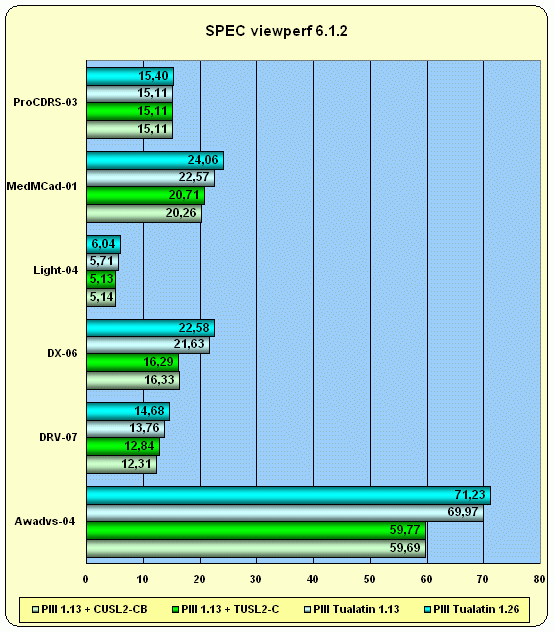 In the SPEC Viewperf the new processor shines only in the Awadvs-04 and DX-06, while in other subtests it has only a very little advantage. 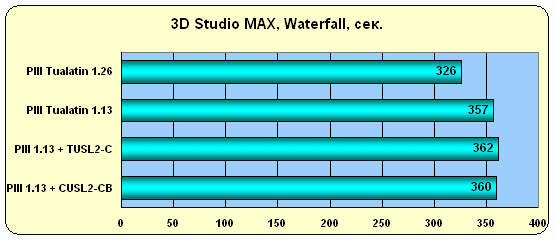 The Tualatin is again a leader but the difference is insignificant. The overclocked processor, however, is beyond comparison. ConclusionWell, is the Tualatin a worthy substitute for the Intel Pentium III Coppermine? The performance shown by the processor is higher in some applications at the expense of a new fab process. But in others the efficiency is not much better because apart from a new fab process and a larger L2 cache the new core has nothing new. The new technological process and the reduced power consumption is a great advantage of the new processor. But the increased overclocking potential doesn't matter much for servers (where Intel positions the Tualatin). However, if we take the desktop version, the situation will be reverse - while the L2 cache's size is not of great interest, its overclockability plays an important role. The mobile version of the Tualatin shines at the expense of a renewed SpeedStep. Reduced power consumption and the updated SpeedStep will be appreciated both by suppliers of servers and workstations on this processor and by portable PC makers. On the low-end server market the AMD's platform has a strong competitor. But the only chipset supporting this processor is i815 B-step, which you will hardly refer to the server platform because of its well-known restrictions. That is why it doesn't make sense to speak about serious systems based on it until a server chipset with Tualatin support will be released. The processor will hardly suit for upgrading computers of home users. The Desktop Tualatin was canceled, and a server version is costy taking into consideration that the performance boost isn't high. In closing I want to say that this processor is of course an excellent product, and now we are to wait for a chipset with which we will be able to build "heavy" systems on the Tualatin. Highs:
Lows:
Write a comment below. No registration needed!
|
Platform · Video · Multimedia · Mobile · Other || About us & Privacy policy · Twitter · Facebook Copyright © Byrds Research & Publishing, Ltd., 1997–2011. All rights reserved. |